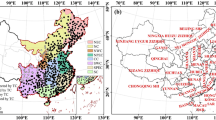Abstract
Tropical Cyclone (TC) activity is an important feature of China’s climate that can have important impacts on precipitation and can cause extensive property damage. In particular, precipitation from TCs contributes a significant portion of overall precipitation. This study deals with typhoons that influence China and focuses on their impact on China’s precipitation. Four aspects are examined in this research. Firstly, the study of influencing typhoon frequency reveals that the main season that typhoons affect China is from May to November, especially between July and September. The frequency of influencing typhoons was steady during the past 40 years. Secondly, inspection of the climatology of station typhoon precipitation shows that Hainan and the southeastern coastalmost regions are most frequently affected by typhoons, and most of the regions south of the Yangtze River are affected by typhoons each year. Meanwhile, during 1957-1996, most of the typhoon-influenced regions show decreasing trends in typhoon precipitation but only the trends in southern Northeast China are significant. Thirdly, examination of the typhoon cases shows that there exists a significant linear relationship between the precipitation volume and impacted area. Finally, study of variations of typhoon impacts on China’s precipitation suggests that there exists a decreasing trend in the contribution of typhoon precipitation to overall precipitation, while total annual volume of typhoon precipitation decreases significantly during the period.
Similar content being viewed by others
References
Chan, J. C. L., 1985: Tropical cyclone activity in the Northwest Pacific in relation to the El Niño/Southern Oscillation phenomenon. Mon. Wea. Rev., 113, 599–606.
Chan, J. C. L., 1995: TC activity in the Northwest Pacific in relation to the stratospheric quasi-biennial oscillation. Mon. Wca. Rev., 123, 2567–2571.
Chan, J. C. L., and J. E. Shi, 1996: Long-term trends and interunnual variability in tropical cyclone activity over the western North Pacific. Geophys. Res. Leu., 23, 2765–2767.
Chen M., Y. G. Zheng, and Z. Y. Tao, 1999: An analysis on tropical cyclones′ climatic feature in the western North Pacific for 1949-1996. Journal of Tropical Meteorology, 15(1), 10–16 (in Chinese).
Elsberry, R. L., W. M. Frank. G. J. Holland, J. D. Jarrell, and R. L. Southern, 1987: A Global View of Tropical Cyclones. university of Chicago Press. 185 pp.
Landsea, C. W.. Nicholls. W. M. Gray, and L. A. Avillia. 1996: Quiet early 1990s continues trend of fewer intense Atlantic Hurricanes. Geophys. Res. Leu., 23, 1697–1700.
Ren, F. M., B. Gleason, and D. R. Easterling, 2001: A technique for partitioning tropical cyclone precipitation. Journal of Tropieal Meteorology, 17(3), 308–313 (in Chinese).
WMO, World Climate Data, and Monitoring Programme, 1995: The Global Climate System Review (Climate System Monitoring, June 1991–November 1993).
Author information
Authors and Affiliations
Rights and permissions
About this article
Cite this article
Fumin, R., Gleason, B. & Easterling, D. Typhoon impacts on china’s precipitation during 1957-1996. Adv. Atmos. Sci. 19, 943–952 (2002). https://doi.org/10.1007/s00376-002-0057-1
Received:
Revised:
Issue Date:
DOI: https://doi.org/10.1007/s00376-002-0057-1




